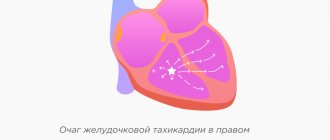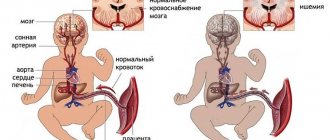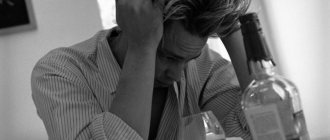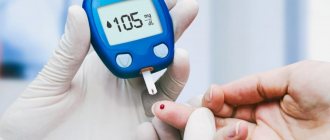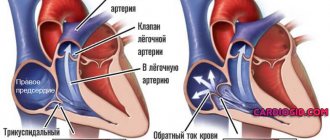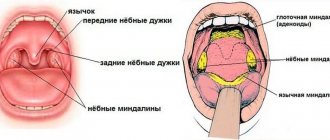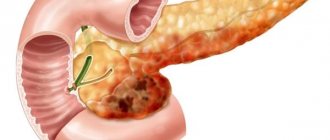Extrasystoles are premature contractions of the heart muscle relative to the normal heart rhythm. Usually, extrasystoles are felt by the patient as a strong cardiac impulse with a dip or fading after it, a feeling of the heart “turning over” in the chest, and some even talk about a short-term “cardiac arrest.” When palpating the pulse at this time, you may feel the pulse wave drop out. At the same time, some extrasystoles may occur unnoticed by the patient.
The cause of extrasystoles is an additionally arising or for some reason activated fragment of the heart muscle that is capable of generating an electrical impulse. This focus of excitation can appear anywhere in the heart. The formation of such a lesion is caused by both diseases of the heart itself (cardiosclerosis, myocardial infarction, inflammatory diseases of the heart muscle, heart defects) and diseases of other organs.
What are extrasystoles?
Extrasystoles are heartbeats that occur outside the physiological rhythm of the heart and can cause unpleasant symptoms.
Extrasystole is also referred to as skipped heartbeats or "cardiac hiccups", and is medically considered a form of cardiac arrhythmia. In most cases, the additional heartbeats are hardly felt or felt very faintly. Regular and severe symptoms are a reason to consult a doctor and diagnose or rule out possible heart disease.
Prognostic classification of ventricular arrhythmias (JT Bigger, 1984)
| Benign | Potentially malignant | Malignant | |
| Manifestation of ventricular ectopic activity | Ventricular extrasystole, no paroxysms of VT | Ventricular extrasystole, episodes of unstable ventricular tachycardia | Sustained paroxysms of VT, VT, VF and PVC |
| Organic heart damage | Absent | Available | Available |
| Clinical manifestations | Interruptions (may be absent) | Interruptions (may be absent) | Interruptions, fainting, circulatory arrest |
| Risk of sudden death | Very low | Essential | Very tall |
PVCs are potentially dangerous in patients with post-infarction cardiosclerosis (PICC).
The risk of sudden death in patients with PICS increases by 2 times in the presence of VT (more than 10 per hour) and by 2-4 times in case of unstable VT.
The effect of PVCs (greater than 10 per hour) and non-sustained VT on mortality in patients with PICS is independent, so the risk of sudden cardiac death increases 4-8 times in the presence of both of these factors (Bigger JT, 1984).
How do extrasystoles occur?
The main cause is an abnormal heart rhythm that occurs outside the sinus node. Extrasystoles can occur in both cardiac patients and healthy people, and often go unnoticed.
Most extrasystoles are harmless. However, they may be symptoms of heart disease. Therefore, if you experience any of the symptoms described below, you should always consult your doctor to rule out or diagnose heart disease.
Depending on the exact location of origin in the heart, they are classified as supraventricular extrasystoles (SVES), which are generated above the level of the ventricle, or ventricular extrasystoles (VES), which are generated in the ventricle.
Extrasystoles can occur in isolation, in pairs or in so-called “short bursts”.
Diagnosis and treatment of extrasystoles
Extrasystoles can be detected on an electrocardiogram, as well as during daily Holter monitoring. Rare extrasystoles do not require treatment if, after examining the patient, no heart disease is detected. If the examination reveals that the extrasystoles are associated with some other disease (diseases of the gastrointestinal tract, endocrine diseases, inflammatory diseases of the heart muscle), the underlying disease is treated.
The doctor should explain what the patient should avoid and what non-drug methods can alleviate the condition and relieve extrasystoles. It is very important that extrasystole caused by disorders of the nervous system and psycho-emotional overload is treated by prescribing sedatives or sedatives. In our age of stress, a properly selected sedative often completely relieves the patient of extrasystoles.
The prescription of antiarrhythmic drugs occurs with mandatory consideration of the types of extrasystoles and heart rate. The selection of antiarrhythmic drugs is made strictly individually and only by a doctor. Remember! All antiarrhythmic drugs have a proarrhythmic effect, that is, they themselves can cause or intensify arrhythmia.
Our doctors select medications based on the latest Russian and international recommendations. Moreover, they have the opportunity to select a drug under ECG control, and the patient does not have to constantly be in the cardiac center. For this we use a remote ECG analysis system. In addition, treatment is monitored using Holter monitoring on average once a month.
If the effect of the drug is good, extrasystoles disappear or are significantly reduced. As a rule, medications need to be taken continuously. In some cases, it is possible to discontinue the medication. But at the same time, the dose of the medication is gradually reduced over a long period of time, since abrupt discontinuation of treatment leads to the recurrence of extrasystoles.
What are the symptoms of extrasystoles?
Typical symptoms of extrasystoles causing abnormal heart rhythms include:
- The heartbeat feels irregular and stronger than usual, or too strong, with a feeling of the heart beating in the throat;
- Feelings of anxiety or panic;
- Sweating;
- Chest pain;
- Feeling of respiratory distress;
- upset stomach or frequent urge to urinate;
- Headache or nausea.
Always consult a cardiologist if these symptoms occur in connection with a pre-existing underlying heart condition.
Causes
NVEs develop due to many reasons.
Even a simple sneeze or fear can cause extraordinary contraction of the myocardium. The most common culprits of extrasystoles are various heart diseases: coronary disease, cardiomyopathy, congenital and acquired defects, myocarditis, pericarditis, chronic heart failure, etc. Also, supraventricular extrasystole develops with the following factors, conditions and diseases:
- violation of autonomic regulation (autonomous dysfunction syndrome);
- physical and emotional stress;
- neurotic disorders;
- reflex irritation of the cardiac nerves in diseases of the gastrointestinal tract: duodenal ulcer, cholelithiasis;
- presence of bad habits;
- coffee addiction;
- taking pills: antidepressants, psychostimulants to reduce appetite, vasoconstrictor nasal drops, medications for high blood pressure. Even some antiarrhythmic drugs in some cases cause EVE;
- infectious diseases;
- severe diseases of the respiratory system: bronchial asthma, chronic broncho-obstructive pulmonary disease;
- pathology of endocrine organs: Graves' disease, Hashimoto's thyroiditis, diabetes mellitus;
- excess or deficiency of minerals in the body (calcium, magnesium, sodium);
- chest injuries.
In some cases, the cause of the rhythm disturbance cannot be identified. Then a diagnosis of “NVE of unknown etiology” is made.
What causes extrasystole?
Among the causes of extrasystoles in healthy people:
- Overwork;
- Lack of sleep;
- Stress;
- Excessive physical and mental stress;
- Potassium or magnesium deficiency;
- Consumption of alcohol, nicotine or coffee.
Extrasystoles can, however, also be a symptom of heart disease, such as:
- Cardiac ischemia;
- Inflammation of the heart muscle;
- Heart valve defect;
- Heart failure;
- Hyperthyroidism.
How to get rid of extrasystole and remove its manifestations
Extrasystole does not occur on its own. It is a manifestation of pathological processes occurring in the myocardium or other organs.
To get rid of arrhythmia you need to:
- Find a specialist to assess the risk and draw up a treatment program.
- Carry out lifestyle corrections, quitting smoking, alcohol, coffee and strong tea;
- healthy food;
- adequate physical activity;
- minimizing stress factors.
Clinical symptoms and treatment of extrasystole are directly related: the more serious the changes in the patient’s condition, the more radical therapy he will need.
Prevention of heart rhythm disturbances
The basic rules of prevention are:
- Therapy of concomitant pathologies of the cardiovascular, circulatory, endocrine and nervous systems.
- Do not self-medicate and do not take strong tranquilizers, hormones, or sedatives.
- Conduct control diagnostics in a timely manner.
The disease of extrasystole is characterized by relapses, therefore, after completing the course of therapy, you should regularly undergo control diagnostics of the heart rhythm.
This article is posted for educational purposes only and does not constitute scientific material or professional medical advice.
Expert advice
For the most effective drug therapy, I recommend that my patients adjust their lifestyle, i.e. avoid factors that provoke the appearance of extrasystoles. To do this, it is necessary to reduce the amount of coffee, “energy” and alcoholic drinks consumed, and completely stop smoking. It is also worth remembering that the presence of PE itself may indicate the presence of another disease. Therefore, you need to try to find out the cause of PE and be examined to look for a possible disease (primarily cardiac).
Diagnosis of extrasystole
A preliminary diagnosis of “extrasystole” is made by a specialist based on an initial examination and collection of an anamnesis of the disease: genetic predispositions, already diagnosed pathologies and patient complaints.
To confirm the diagnosis and select a therapeutic regimen, the patient is prescribed:
- ECG
. - Bicycle ergometry
. - Load test.
- ECG-Holter (24-hour monitoring)
. - Ultrasound of the heart
(if necessary). - MRI (if necessary).
Based on the diagnostics performed, the cardiologist clearly sees the foci of occurrence and the type of extrasystoles (atrioventricular, ventricular or atrial).
Clinical case
Last week I observed a 47-year-old man who came to me with complaints of dizziness, periodic sensations of “fading” of the heart, and a feeling of lightheadedness.
Among the bad habits the patient noted was smoking tobacco with an experience of 26 years. Upon examination, I found an irregular pulse, dry rales in the lungs and slight blueness of the lips. Upon detailed questioning, the patient said that in recent months he began to notice sputum discharge in the morning and shortness of breath during physical activity. I ordered Holter ECG monitoring, chest x-ray and spirometry (respiratory function test). The ECG shows frequent atrial extrasystole (polytopic) with a total number of ES per day of 843. The X-ray shows signs of chronic bronchitis. Spirography showed impaired patency of the small bronchi. Based on these data, a diagnosis of “Chronic obstructive pulmonary disease of moderate severity” was made. Seretide (a combination drug in the form of a powder inhaler) and Verapamil were prescribed for treatment. Recommendations for lifestyle changes are given.
General recommendations
First of all, the cause of the disease is determined, which may involve disorders of both the cardiovascular system and other organs and systems of the body. In the latter case, they talk about non-cardiac causes of the development of pathology.
If the clinical picture is not pronounced and extrasystoles do not occur frequently (except for early and polytopic ones), drug treatment is not carried out.
The absence of indications for taking medications does not mean that you can ignore your heart condition. You can support a vital organ in other ways, for which you need to follow general recommendations:
- Eat foods that are good for your heart, which should first of all be free of animal fat, fried, smoked, spicy, and highly salted foods.
- Tolerate less psycho-emotional stress, which significantly disrupts the activity of the heart.
- Regularly perform acceptable physical exercises that will help saturate the myocardium with oxygen.
- Give up bad habits, among which smoking and drinking alcohol have a particularly negative effect on the heart.
- The daily routine should be observed as much as possible, especially for night sleep, which should last at least 8 hours.
Lifestyle changes can improve your well-being without medication. The recommendations given are useful for all cardiac patients, including those with indications for taking medications.

